We receive and publish the following review of the book Caravaggio, Nostra Signora della Misericordia by Gianluca Forgione (texts) and Mauro Magliani (photographs), ArtchivePortfolio editions.
Those who will have visited the ongoing Caravaggio Napoli exhibition at the Capodimonte Museum will not have failed to notice among the new additions to the bookshop an editorial product that already stands out in terms of its technical features, and will also be intrigued by the absence of any particular information about its contents. Rather slender and large-format (33x24 cm), in the paperback cover appear some details of the ’great absentee’ in the exhibition halls - rightly or wrongly depending on your point of view - Seven Works of Mercy. Or, rather, Our Lady of Mercy, as indicated in an eighteenth-century transcription of the bill of payment to Caravaggio, which is then also the title of the booklet discussed here.
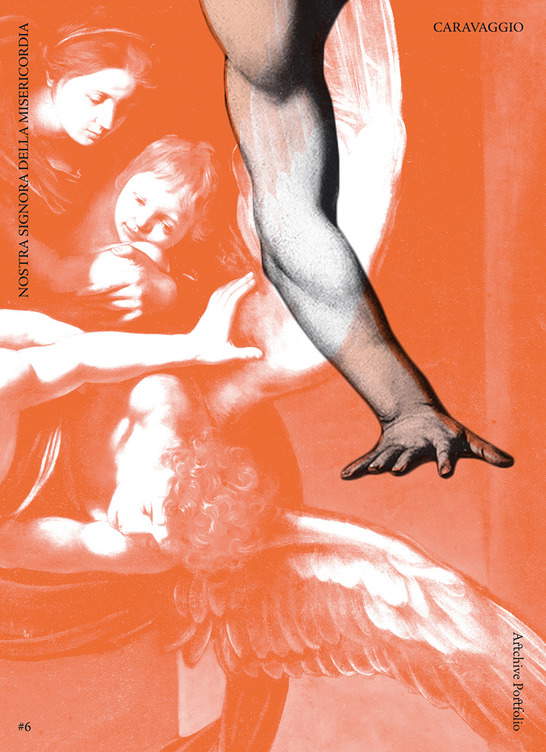 |
| Gianluca Forgione and Mauro Magliani, Caravaggio, Our Lady of Mercy (ArtchivePortfolio, 2019) |
It represents the sixth and most recent issue of photographer Mauro Magliani’s ArtchivePortfolio project. Each issue of the series describes precisely a single work through a rich illustrative kit, of high aesthetic and technical quality and specially created, and a text in constant dialogue with those same images, which are presented in the form of loose plates. There are as many as 42 of them in our case, some taking up several pages, and on the whole they allow us to fully grasp the intricate iconography of the canvas, which is rich in details-which escape the normal vision of the visitor to the Pio Monte di Misericordia, but which even not all the available photographs rendered with an appreciable level of detail.
And it is precisely to the iconography of the painting that the paper by Gianluca Forgione, a young Neapolitan scholar, is dedicated (in the series, essays are always entrusted to young art historians). It will have come naturally to his name, considering that he is a student of the late Vincenzo Pacelli, the greatest connoisseur of Neapolitan Caravaggio, with whom he edited his last great monograph Caravaggio tra arte e scienza. Forgione, moreover, had edited in 2014 the posthumous reissue of his master’s volume devoted precisely to the great altarpiece of Via dei Tribunali and, more recently, had expounded his studies on the subject as part of a symposium(Evidenza Caravaggio).
In fact, the essay is an anticipation of the results of personal research that will be published in a more extensive form, or at least supplementing the illustrative and textual apparatus. After all, the way ArtchivePortfolio is conceived in this #6 there can be no place, other than for an apparatus of notes, even for images of other paintings and printed works, which are often referred to for analogies. And it is by anchoring Merisi’s invention in the tradition from which it descends that it has been possible to reconsider the meaning of the work and to reread some of the charitable episodes depicted in a new perspective. Beginning, looking further up, with the observation that one of the drapes enveloping the angels, more specifically the one descending on the crowd, is not black (as has also been advanced recently by a general misreading of the painting), but dark green. This notation of a chromatic character, seemingly simple in its evidence and yet eluded by most, is of great importance, since the drape in question is connected to the Virgin’s mantle, of which it can be said to be an integral part in all respects; so much so as to confirm a derivation from the classic image of Our Lady of Mercy, in which the Mother of Jesus protects the faithful under her cloak. And this is an even more important observation as it belies those who also in the past did not want to recognize, for the altarpiece of the Pio Monte, a relationship of descent from those ancient iconographies.
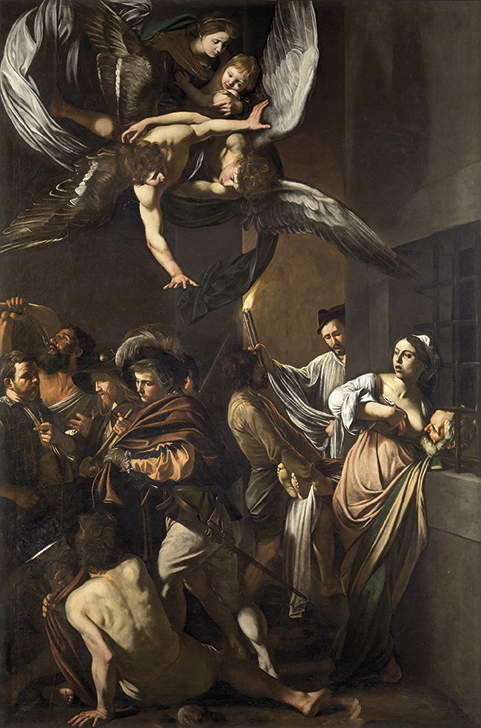 |
| Michelangelo Merisi known as Caravaggio, Our Lady of Mercy (1606-1607; Naples, Pio Monte della Misericordia). Ph. Credit Mauro Magliani |
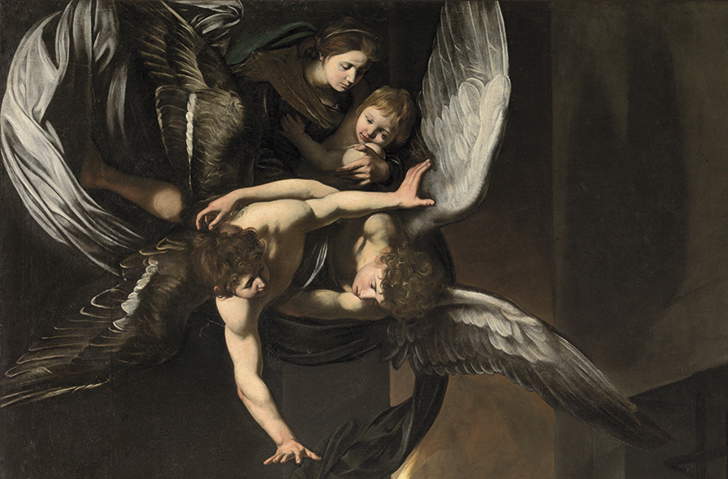 |
| Caravaggio, The Seven Works of Mercy, detail |
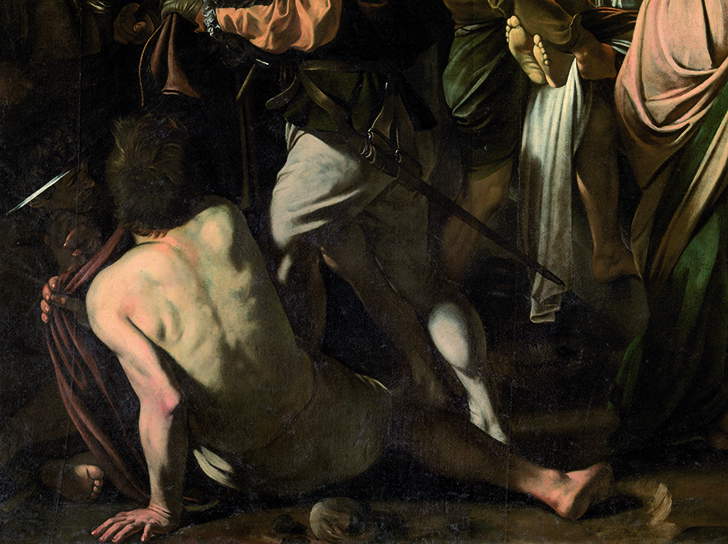 |
| Caravaggio, The Seven Works of Mercy, detail. Ph. Credit Mauro Magliani |
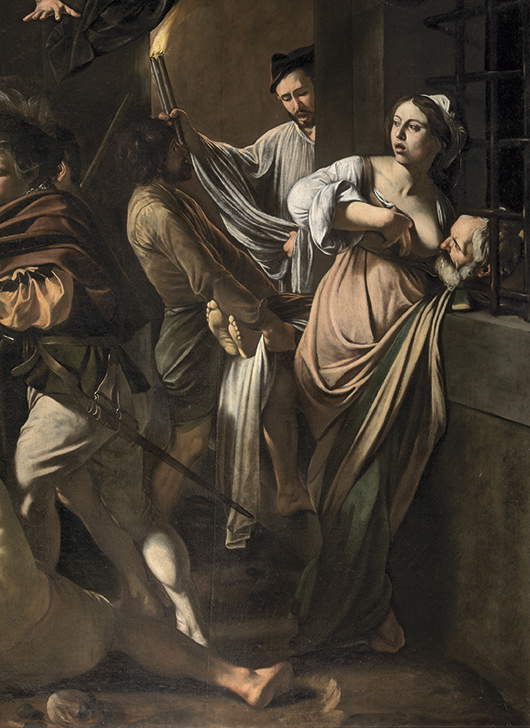 |
| Caravaggio, The Seven Works of Mercy, detail. Ph. Credit Mauro Magliani |
But this is only the beginning of Forgione’s work. For whom the image of the Caravaggesque Seven Works seems to have accompanied him all along, firmly imprinted in his mind, so thorough does his examination turn out to be and so numerous are the connections established with works by authors of all times and places. Much more will be encountered in the reading, perhaps not all of which can be shared and which at times should be taken more as a suggestion; but which in any case opens up a discussion and is a stimulus to ask more than one question: it should not be forgotten that, more generally, Merisi’s Neapolitan production is certainly not among the most investigated (of which the Capitoline one is always favored).
Among several cues, one appears convincing and, one might say, unanimously agreeable, so it is worth quoting it in full:"In the primitive church of Pio Monte, which is smaller than the present one, Merisi’s painting was probably placed lower down, and Caravaggio’s invention, in the overall view of the individual scenes, must have been all the more impressive, on a par with the illusionistic breakthrough effect that still determines the Beheading of the Baptist in the chapel of the same name in the co-cathedral of Malta." An insight, this one, that would have benefited the hypotheses around the configuration of the original sacred building, which has been discussed lately in the context of Caravaggio Napoli.
Speaking of exhibitions, in the appendix to the volume, in addition to the basic and specific bibliography, there are lists of the restorations that between 1670 and 2004 affected the painting and of the exhibitions in which precisely it was exhibited (in 1983 in Washington for example, but those were other times).
Our Lady of Mercy, which comes out in a print run of 1,100 copies with a low price (€22), also available in theEnglish edition, is a work that cannot and should not be missing from the personal libraries of enthusiasts, even before scholars; of the great Lombard and, of course, of the painting in question in particular. It is a capital and inventive work, which immediately made manifest the Caravaggesque genius in the Neapolitan context of the time and which, that same talent, testifies today on a universal scale.
Warning: the translation into English of the original Italian article was created using automatic tools. We undertake to review all articles, but we do not guarantee the total absence of inaccuracies in the translation due to the program. You can find the original by clicking on the ITA button. If you find any mistake,please contact us.